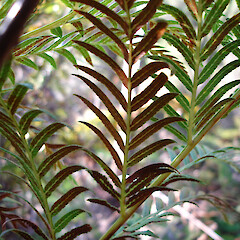Todea barbara
Common name
royal fern, hard todea, king fern
Synonyms
Acrostichum barbarum L., Osmunda barbara Thunberg, Todea africana Willd.
Family
Osmundaceae
Flora category
Vascular – Native
Endemic taxon
No
Endemic genus
No
Endemic family
No
Structural class
Ferns
Chromosome number
2n = 44
Current conservation status
The conservation status of all known New Zealand vascular plant taxa at the rank of species and below were reassessed in 2017 using the New Zealand Threat Classification System (NZTCS) – more information about this can be found on the NZTCS website. This report includes a statistical summary and brief notes on changes since 2012 and replaces all previous NZTCS lists for vascular plants.
Please note, threat classifications are often suggested by authors when publications fall between NZTCS assessment periods – an interim threat classification status has not been assessed by the NZTCS panel.
- Conservation status of New Zealand indigenous vascular plants, 2017 . 2018. Peter J. de Lange, Jeremy R. Rolfe, John W. Barkla, Shannel P. Courtney, Paul D. Champion, Leon R. Perrie, Sarah M. Beadel, Kerry A. Ford, Ilse Breitwieser, Ines Schönberger, Rowan Hindmarsh-Walls, Peter B. Heenan and Kate Ladley. Department of Conservation. Source: NZTCS and licensed by DOC for reuse under the Creative Commons Attribution 4.0 International licence.
2017 | Threatened – Nationally Vulnerable | Qualifiers: SO
Previous conservation statuses
2012 | Threatened – Nationally Endangered | Qualifiers: SO
2009 | Threatened – Nationally Endangered | Qualifiers: SO
2004 | Threatened – Nationally Endangered
Distribution
Indigenous. New Zealand: North Island (Poor Knights Islands and locally from Te Paki south to about Dargaville and the Bay of Islands). Common in South Africa and Australia.
Habitat
Coastal to lowland areas. A species of gumland scrub, coastal shrublands, and streamside margins in open forest, occasionally found on coastal cliffs or on serpentinite. Often found on bare claybanks or fringing sinkholes in gumland scrub.
Detailed description
Extremely, robust, coriaceous ferns producing trunks up to 1 m tall. Stipes smooth, 150–600 mm, yellow brown, with ear–like lobes at base. Fronds persistent, coriaceous, 0.25–0.65 × 1.2–3.5 m, ovate, elliptic to lanceolate, 1-pinnate-pinnatifid to 2-pinnate, glabrous or finely pubescent along veins, glossy, upper surface pale green, yellow-green to golden yellow, undersides similar but paler. Pinnae 20–60 × 4–10 mm, lanceolate, narrowly oblong, to ovate; pinnules broadly attached at base, 15–80 × 4–9 mm, oblong-elliptic, apex acute, margins toothed; sporogenous pinnae occasionally shorter than sterile ones, restricted to lower part of frond, on lower pinnules of primary pinnae, at first in discrete groups, then confluent, green turning reddish brown.
Similar taxa
A well marked species quite unlike any other indigenous or cultivated species of fern present in New Zealand. However, there has been some confusion with the introduced royal fern, Osmunda regalis L., perhaps because both species share the same vernacular. Osmunda regalis is an aggressive species, which is readily distinguished from Todea by the deciduous habit, softer pale-green to blue-green fronds, and by the fertile portion of the frond occurring as a distinct branchlet at the apex of the frond.
Flowering
Not applicable—spore producing
Flower colours
No flowers
Fruiting
Not applicable—spore producing
Propagation technique
Very easily grown in any sunny, frost-free site. Will tolerant quite extreme conditions including very dry and very wet habitats but does best in a sunny, free draining soil.
Threats
Threatened by habitat loss through land clearance and competition from weeds such as Hakea spp. and pampas grass (Cortaderia selloana (Schult. et Schult.f. ) Asch. et Graebn.). Some populations have been eliminated by people collecting plants for the horticultural trade. At least one major population, that on Aorangi Island, Poor Knights Islands group is threatened by natural succession from open shrubland to coastal forest.
Attribution
Fact Sheet prepared for NZPCN by P.J. de Lange 1 August 2003. Description based on Chinnock (1998) but see also de Lange et al. (2010)
References and further reading
Chinnock RJ. 1998. Osmundaceae. Flora of Australia 48, Ferns Gymnosperms and allied groups: 112–115. ABRS/CSIRO Victoria, Australia.
de Lange PJ, Heenan PB, Norton DA, Rolfe JR, Sawyer JWD. 2010. Threatened Plants of New Zealand. Canterbury University Press, Christchurch. 471 p.
NZPCN Fact Sheet citation
Please cite as: de Lange, P.J. (Year at time of access): Todea barbara Fact Sheet (content continuously updated). New Zealand Plant Conservation Network. https://www.nzpcn.org.nz/flora/species/todea-barbara/ (Date website was queried)












